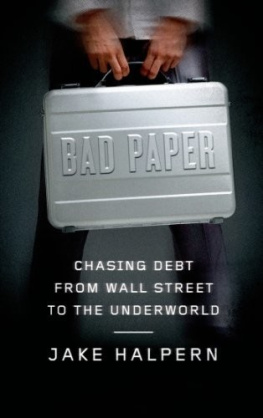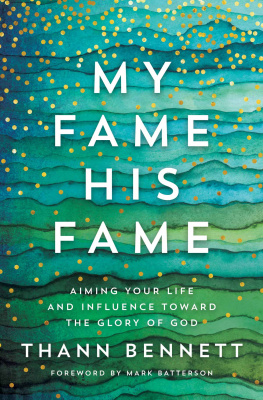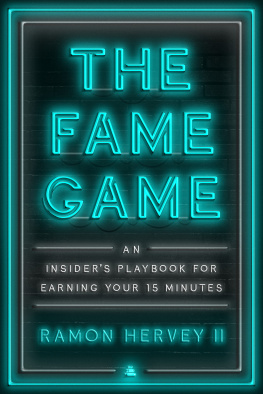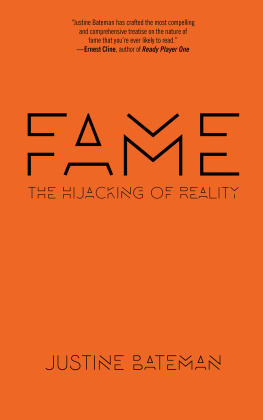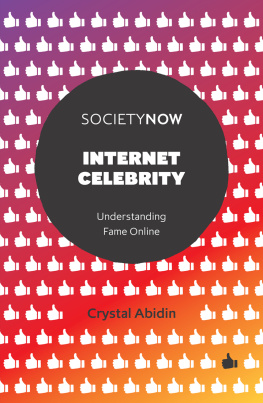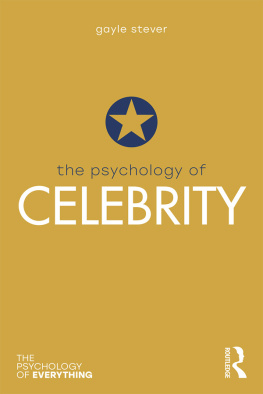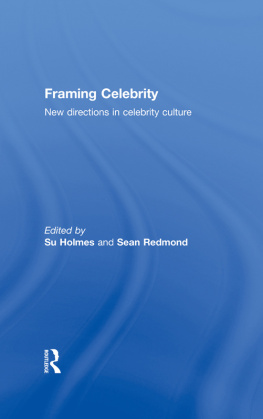FAME
junkies
The Hidden Truths Behind America's Favorite Addiction
Jake Halpern
Copyright 2007
ISBN-13: 978-0-618-45369-6
To my brother, Greg
Contents
Introduction: Hooked on Fame xi PART I
The World of Aspiring Child Celebrities
1 Going to Fame School 3
2 Mobs of Fame-Starved Children 24
3 A Home for the Famous and the Almost Famous 53
PART II
The Celebrity Entourage
4 The Association of Celebrity Personal Assistants 81
5 The Desire to Belong: Why Everyone Wants to Have Dinner with Paris Hilton and 50 Cent 105
6 When Reflected Glory Isn't Enough: Confessions of an Upwardly Mobile Celebrity "Slave" 125
PART III
The World of Celebrity Worshipers
7 Monkeys, Us Weekly, and the Power of Social Information 141
8 A Choice of Worship: Rod vs. God 159
Conclusion: Some Reflections from Hollywood's Premier Retirement Home 185
Note on Name Changes 199 Appendix 200 Acknowledgments 214 Notes 217
Introduction: Hooked on Fame
Several months before he became famous, seventeen-year-old Jerrell Jones visited the Black Pearl tattoo parlor, in downtown St. Louis, and made an unusual request: he wanted a six-inch-long bar code, complete with a minute serial number, etched on his forearm in dark-green ink. As far as Jones was concerned, his decision to get the tattoo was just one more step on the path to fame. Prior to this, he had run away from his home in the suburbs and spent several months living the life of a vagabond on the streets of St. Louis, sleeping in abandoned cars and writing rap lyrics by the flame of a cigarette lighter. During this time he renamed himself J-Kwon, and began to prepare for the fame he felt was imminent. "I got the bar code because I knew that someday I'd be a product," he told me in 2003. "I knew they were going to sell me."
He was right.
J-Kwon eventually enlisted the help of two local rap producers, known as the Trackboyz. Together they recorded his debut album, Hood Hop, and sold it to Arista Records. It wasn't long before hangers-on began to swirl around J-Kwon like debris in a cyclone. They included several personal assistants, one of whom was a teenager known as "Versatile"though J-Kwon soon renamed him "Four," in homage to the rapper Nelly, who apparently had an assistant named "Three." Another member of J-Kwon's extended entourage was an almost-famous rapper named 40 Grandor "Uncle 40," as J-Kwon sometimes called
himwhose primary job was to recount his own failures and serve as a kind of living cautionary tale. The dozen or so members of J-Kwon's entourage followed him around, gave him advice, offered him protection, lavished praise on him, and did whatever they could to seal their mutual fate and garner a oneway ticket out of obscurity.
As J-Kwon's hit song "Tipsy" began to get more airplay, the frenzy surrounding him mounted. While visiting a Foot Locker at a St. Louis shopping mall, he drew such a crowd that mall officials closed off the store and asked him to call ahead in the future so that they could arrange for extra security. After a show in Birmingham, Alabama, a mob of fans grew so rowdy that J-Kwon needed a police escort back to his hotel. In Los Angeles, which he visited to appear on The Tonight Show with Jay Leno, a woman approached him and said that the seventeen-year-old rapper had changed her life and that she wanted to have his baby.
In the span of just a few months I witnessed J-Kwon evolve from a marginalized teenager into a bona fide celebrity. I chronicled much of what I saw in an article for The New Yorker, but long after its publication the story remained firmly embedded in my thoughts. Talk of celebrities may be ubiquitous, but fame itself is still the rarest of commodities. And everybodyincluding J-Kwon, Uncle 40, Four, the screaming hordes in Alabama, the would-be mother to his child in Los Angeles, and meall of us were beguiled by it. On some fundamental, almost primal level, it seemed as if we were all hungry for a taste of it.
I will be the first to admit that writing about fame is a stretch for me. I grew up far from the glitz of Hollywood, in the Rust Belt city of Buffalo, New York, with a leftist father who for years wore a massive Castro beard, and a mother who accumulated advanced degrees but, despite my best efforts to teach her otherwise, constantly confused Bob Marley with Barry Manilow. The closest I got to "glamour" was donning my moon boots and polar parka to trudge through the snow for a screening of Wres-
tleMania at my neighbor's house. Even years later, during my first encounter with a Hollywood agent, I asked so many obvious and apparently naive questions that he finally snapped, "Kid, where the hell are you from, Buffalo?"
My first real exposure to celebrity culture was in the mid-1980s, during my early adolescence, when my parents briefly acquiesced to my demands for cable television. Almost immediately my show of choice became Lifestyles of the Rich and Famous, which first aired in 1984. On wintry evenings, as gale-force winds howled through the deserted streets of North Buffalo, I cozied up to the warm glow of the TV and let the host, Robin Leach, whisk me into a rarefied world of private yachts and gold-plated bathroom fixtures. Perhaps needless to say, these things weren't too common in Buffaloespecially during the 1980s, when the city was still reeling from the loss of the steel industry.
Looking back, it seems odd to me that Lifestyles of the Rich and Famous was so popular. In other times and places the flaunting of such discrepancies in wealth has incited revolution, but for some reason this show did precisely the opposite: it enthralled millions of middle-class viewers like me. I was a ridiculously skinny, uncoordinated kid, so I avoided sports, read way too many books, and talked pretty much continually. I must have set off an almost Pavlovian response in schoolyard bullies. Robin Leach seemed to provide a reprieve from all this. For thirty minutes his show allowed me to escape from the cramped confines of our family roomwith its water-stained ceiling and buzzing radiatorsand enjoy an intoxicating dose of glamour.
One of the many things that still fascinate me about Lifestyles of the Rich and Famous is that no rich or famous people were actually on the show. We, the viewers, saw only these people's possessions. In a way, the whole show functioned as one continuous "point-of-view shot," which is what facilitated the voyeurism of it all. And I'm pretty sure that's why I liked the show so much. Once a week it allowed me to imagine that I was in Malibu, or Beverly Hills, mingling with the glitterati, bark-
ing orders at my butler, or receiving fan mail in my mahogany-paneled study. At the time, I was only nine years old, but I was clearly already nursing delusions of grandeur and beginning to fixate on the idealized notion of what it meant to be a celebrity.
My parents eventually became so annoyed with my weekly devotion to Lifestyles of the Rich and Famous that they actually gave away our television set, thus ending my obsession with Robin Leach and the world he advertised. To fill the void they bought me a bicycle, and when the weather permitted, I channeled my time and energy into cycling. Still, I suffered momentary relapses. I'd go to a friend's house for a sleepover, and before I knew it I was glancing at the television and pining for the sound of Robin Leach's English accent.
Even today a similar urge lingers. The big difference now is the number of "celebrity news" outlets. All you have to do is click on E!, the twenty-four-hour celebrity-news network, or buy a copy of Us Weekly and turn to the "StarsThey're Just Like Us!" section for news about Brad and Angelina's latest tropical vacation. And I still get sucked in. I'll be walking through an airport, hustling toward my gate, and the next thing I know I'm standing beneath a television set, watching a segment on Julia Roberts's adorable children. As I'm absorbing every last word of this pap, somewhere in the back of my head the faintest of voices is asking, "Why on earth do you care?"
Next page
